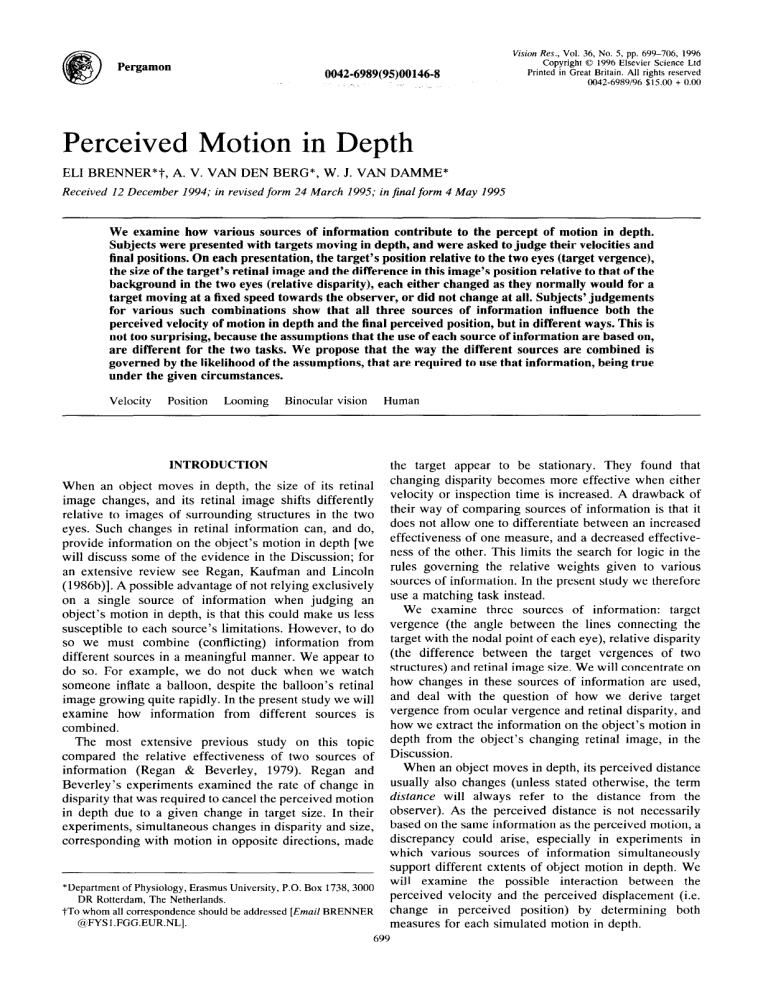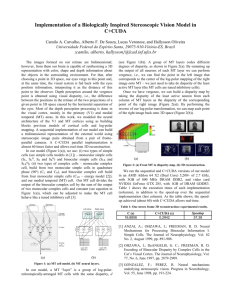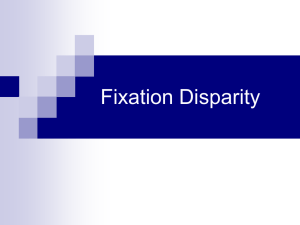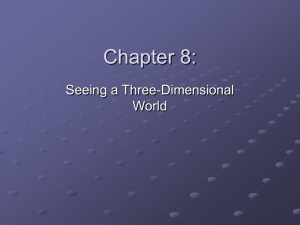
Pergamon
0042-6989(95)00146-8
,
Vision Res., Vol. 36, No. 5, pp. 699-706, 1996
Copyright 0 1996 Elsevier Science Ltd
Printed in Great Britain. All rights reserved
0042-6989196 $15.00 + 0.00
Perceived Motion in Depth
ELI BRENNER*I_,
Received
A. V. VAN DEN BERG*,
12 December
W. J. VAN DAMME*
1994; in revised form 24 March 1995; in final form 4 May 1995
We examine how various sources of information contribute to the percept of motion in depth.
Subjects were presented with targets moving in depth, and were asked to judge their velocities and
final positions. On each presentation, the target’s position relative to the two eyes (target vergence),
the size of the target’s retinal image and the difference in this image’s position relative to that of the
background in the two eyes (relative disparity), each either changed as they normally would for a
target moving at a fixed speed towards the observer, or did not change at all. Subjects’ judgements
for various such combinations
show that all three sources of information
influence both the
perceived velocity of motion in depth and the final perceived position, but in different ways. This is
not too surprising, because the assumptions that the use of each source of information are based on,
are different for the two tasks. We propose that the way the different sources are combined is
governed by the likelihood of the assumptions, that are required to use that information, being true
under the given circumstances.
Velocity
Position
Looming
Binocular
vision
Human
INTRODUCTION
the target appear to be stationary.
They found that
changing disparity becomes more effective when either
velocity or inspection time is increased. A drawback of
their way of comparing sources of information
is that it
does not allow one to differentiate
between an increased
effectiveness
of one measure, and a decreased effectiveness of the other. This limits the search for logic in the
rules governing
the relative weights given to various
sources of information.
In the present study we therefore
use a matching task instead.
We examine
three sources of information:
target
vergence (the angle between the lines connecting
the
target with the nodal point of each eye), relative disparity
(the difference
between
the target vergences
of two
structures) and retinal image size. We will concentrate on
how changes in these sources of information
are used,
and deal with the question of how we derive target
vergence from ocular vergence and retinal disparity, and
how we extract the information on the object’s motion in
depth from the object’s changing retinal image, in the
Discussion.
When an object moves in depth, its perceived distance
usually also changes (unless stated otherwise, the term
distance
will always refer to the distance
from the
observer). As the perceived distance is not necessarily
based on the same information as the perceived motion, a
discrepancy
could arise, especially
in experiments
in
which various sources of information
simultaneously
support different extents of otject motion in depth. We
will examine
the possible
interaction
between
the
perceived velocity and the perceived displacement
(i.e.
change
in perceived
position)
by determining
both
measures for each simulated motion in depth.
When an object moves in depth, the size of its retinal
image changes, and its retinal image shifts differently
relative to images of surrounding
structures in the two
eyes. Such changes in retinal information
can, and do,
provide information
on the object’s motion in depth [we
will discuss some of the evidence in the Discussion;
for
an extensive review see Regan, Kaufman and Lincoln
(1986b)]. A possible advantage of not relying exclusively
on a single source of information
when judging
an
object’s motion in depth, is that this could make us less
susceptible
to each source’s limitations.
However, to do
so we must combine
(conflicting)
information
from
different sources in a meaningful
manner. We appear to
do so. For example, we do not duck when we watch
someone inflate a balloon, despite the balloon’s retinal
image growing quite rapidly. In the present study we will
examine
how information
from different
sources is
combined.
The most extensive
previous
study on this topic
compared
the relative effectiveness
of two sources of
information
(Regan
& Beverley,
1979). Regan and
Beverley’s
experiments
examined the rate of change in
disparity that was required to cancel the perceived motion
in depth due to a given change in target size. In their
experiments,
simultaneous
changes in disparity and size,
corresponding
with motion in opposite directions, made
*Department of Physiology, Erasmus University, P.O. Box 1738, 3000
DR Rotterdam, The Netherlands.
tTo whom all correspondence should be addressed [Email BRENNER
@FYSI.FGG.EUR.NL].
699
700
ELI BRENNER
Far
Near
et al.
plant:
plane
FIGURE 1. Two examples of the kind of targets used in our experiments.
The shape of the target was changed whenever a
setting had been made. Each target was built up of three triangles. Two of these triangles shared two comers, which were at
random positions along opposite sides of the near plane of an imaginary cube (indicated by arrows). Each had its third comer at a
random position on one of the orthogonal sides of the far plane. The third triangle was on a plane parallel to the cube’s near plane
and half-way between the near and far planes. This triangle’s corners were at random positions within an area that was 4 times as
large as the cube’s planes, with the restriction that the triangle must intersect the other two triangles. The imaginary cube had
sides of between 1.5 and 6 cm (determined at random). The matching target was a cube with sides of 3 cm. With target distance
we always refer to the distance to the near plane.
We find that target vergence, relative disparity, and
retinal image size contribute differently to the perceived
velocity and to the perceived displacement.
We discuss
how this may be related
to the advantages
and
disadvantages
of each of the three sources of information.
METHODS
There were four experiments.
In all four, selected
sources
of information
specified
that a target was
approaching
the observer, whereas the others specified
that it was static. In two experiments we asked subjects to
indicate the target’s velocity. In the other two we asked
them to indicate
the position
at which the target
disappeared.
For each task the difference
between the
two experiments
was whether
all sources
provided
similar
information
on the target’s
distance
at the
beginning or at the end of the presentation.
All the experiments
were performed
with simulated
objects on a computer screen (Silicon Graphics GTX-210
computer and HL69SG monitor). The screen was 34 cm
wide (1280 pixels)
and 27 cm from top to bottom
(492 pixels). Screen luminance
was 13 cd/m2 for light
pixels and 0.02 cd/m2 for dark ones. Perspective projection was used to display objects on this screen. Subjects
sat with their head in a chin-rest at 60 cm from the screen.
Images were presented at a rate of 120 Hz. LCD shutter
spectacles ensured that alternate frames were presented to
the left and right eyes. Each frame provided a new image;
with the appropriate perspective for the eye for which it
was intended (taking account of the separation between
individual subjects’ eyes) and the target at its simulated
position at that moment. Red stimuli were used because
the LCD shutter spectacles work best at long wavelengths
(about 33% transmission
when “open” and 0.3% when
“shut”). The room was dark, so that subjects were unable
to see anything except for the image on the screen.
The target that moved in depth was a complex shape
built up of three triangles (see Fig. 1). It moved for 1 set
at a constant simulated velocity of 21.6 cm/set towards
the observer (either starting or stopping at a distance of
60 cm; the real distance to the screen). The target’s size
varied between trials. This variability, and the complexity
of the target, was done to discourage
subjects from
judging the target’s distance from assumptions
on the
simulated size.
The matching target was a cube with sides of 3 cm.
When matching velocities, this cube moved from left to
right at a velocity that was set by the subject (at a distance
of 60 cm; reaching the centre of the screen half-way
through the 1 set presentation).
When matching
the
position at which the target disappeared,
it remained
stationary at a distance that the subject could set (target
vergence,
size and relative disparity
all changing
in
accordance with that distance).
The background
(for both targets) consisted
of 12
simulated
triangles with sides of 12 cm. The triangles
were not all at the same simulated distance, but were at
(randomly
chosen) distances
between
80 and 100 cm
(when the target moved from 60 to 38.4 cm away), or
PERCEIVED MOTION IN DEPTH
between 100 and 120 cm (when the target moved from
81.6 to 60 cm away). The triangles were more or less
randomly distributed within the boundaries of the screen.
Their positions varied with each presentation.
When the target started at a distance of 60 cm, the
initial information on the target’s distance (target
vergence, range of relative disparities and range of
possible target image sizes) was the same for all
conditions. The jinal target vergence and range of
relative disparities were therefore highly correlated with
the changes in these measures (this was less so for retinal
target size, because the simulated target size was varied
between trials). When the targets stopped at 60 cm, the
converse was true. In the latter case there was no
correlation between the final values and the changes
during the presentations (note that the motion also took
place at a larger simulated distance).
Perceived velocity
When making their settings, subjects were free to look
at the target and matching motions as often as they
pleased. There were no restrictions on eye movements.
Subjects were presented with the target motion (in depth)
if they pressed the left mouse button, and with the
matching (lateral) motion if they pressed the right button.
The velocity of the lateral motion was determined by the
position of the mouse. When satisfied with the setting, the
subject pressed the middle mouse button and the next
condition was presented. There were eight conditions,
each of which was presented five times to each subject,
all in random order.
Perceived final position
Subjects were shown the target motion once, after
which the matching cube appeared (at a random
distance). The subject’s task was to move the cube to
the position at which the target disappeared. They were
informed that we consider the simulated position of the
near plane (see Fig. 1) to be the target’s distance. The
cube’s simulated distance was determined by the position
of the mouse. Matches were made for the same eight
conditions, as well as for two additional conditions in
which the targets were static (at distances of 60 and
38.4 cm). Each condition was presented 10 times to each
subject, in random order.
The simulations of motion in depth (the eight conditions)
The first condition was a full simulation of a target
moving towards the observer. The target images destined
for the two eyes were shifted in opposite directions across
the static background, changing target vergence and
relative disparity by about 3.5 deg for targets that start
60 cm away, and by about 1.5 deg for targets that stop
there. The size of the target’s image increased by 56% for
the nearer motion and 36% for the more distant motion.
As we used three-dimensional targets, the difference in
disparity between near and far parts of the target also
changed during the presentation (by about 25 and
10 min arc), and the target’s orientation relative to the
701
line of sight changed in opposite directions in the two
eyes. The changes in vertical disparity that should have
occurred during the target’s motion in depth were smaller
than the vertical resolution of our display, and close to the
resolution of the human eye. The required accommodation obviously also did not change when the target’s
distance changed, but accommodation is known to be a
poor cue for judging distance (Collewijn & Erkelens,
1990; Sedgwick, 1986).
The second, third and fourth conditions consisted of
selectively eliminating changes in target vergence,
relative disparity and target image size. Selectively
eliminating changes in target vergence maintains all
changes in the image reaching each eye, but the eyes do
not have to move to maintain fixation on the target. This
is accomplished by rotating the whole simulated scene
independently (in opposite directions) around the two
eyes to compensate for the change in target vergence,
before effecting the perspective projection on the screen.
Selectively eliminating changes in relative disparity
leaves all changes to the target’s image intact. The
background’s image on the screen shifts together with the
target so that the relative disparity between the target’s
near plane and the background does not change (i.e.
background VergenceAefined
in analogy with target
vergence+hanges
by the same amount as target
vergence). Selectively eliminating changes in image size
is accomplished by not changing the size of the target’s
image on the screen. The simulation corresponds with an
approaching target which shrinks as it comes closer.
The fifth, sixth and seventh conditions consisted of
isolated changes in target image size, relative disparity
and target vergence. An isolated change in target image
size is a simulation of a growing target (with its size
increasing in accordance with the change in retinal image
size during the full simulation). An isolated change in
relative disparity is achieved by rotating the background
in opposite directions around the eyes (decreasing
background vergence by the angle with which target
vergence would normally increase). Target vergence was
changed on its own by rotating the initial scene
independently (in opposite directions) around the two
eyes, before effecting the perspective projection on the
screen, so that the eyes had to be converged to maintain
fixation but the image on each retina did not change.
The eighth condition was a simulation of motion of the
background away from the observer. The change in
relative disparity was identical to the change when the
target moved towards the observer. To achieve this, we
calculated (for each frame) how much each background
element would have to move backwards to cause the
same change in relative disparity as is caused by the
approaching target in the full simulation. This motion of
the background is then simulated. As a result, the
stimulus is identical to that in the condition in which an
isolated change in relative disparity is shown, except that
the background “shrinks”.
702
ELI BRENNER
et al.
I
.
.._.~._.....f.............._
FIGURE 2. Median and intra-quartile
range of seven subjects’ average
ratios between the set lateral velocity of the matching target and the
target’s simulated velocity of motion in depth (always 21.6 cmisec),
for each condition. V, target vergence; RD, relative disparity between
target and background;
S. target image size; 0, the initinl image on the
screen was always the same: 0, the final image on the screen was
always the \ame; dotted line. perfect performance.
Subjects always
underestimated
the motion in depth. Although
changes
in target
vergence alone did not give rise to a percept of motion in depth, their
absence
did reduce the perceived
velocity.
Changes
in relative
disparity alone (by changing background
vergence) resulted in some
perceived
target motion in depth, but this could be climinatcd
by
making the background
contract as if it were moving away. Changes in
target image size contribute very strongly to the perceived motion in
depth.
i
FIGURE 3. Median and intra-quartile
range of the average positions at
which the same seven subjects saw the targets disappear,
for each
condition.
V. target vergence;
RD, relative disparity between target
and background;
S, target image size; solid symbols, the initial image
on the screen was always the same; open symbols, the final image on
the screen was always the same; dotted lines, perfect performance.
When the targets were static (at 3X.4 or Ocm;
squares), subjects
performed quite accurately.
When the targets moved (circles), target
vergence,
relative disparity,
and changing
target image size contributed to about the same extent to the final perceived position. Note
that the final target vergence and relative disparity always indicate a
distance of 60 cm for the more distant motion (open symbols), whereas
the final distance they indicate depends on how much they changed for
the nearer motion (solid symbols).
Subjects
Apart from the first author, all subjects were colleagues
who were aware of the questions being dealt with, but not
of the specific stimuli. All had normal (corrected) acuity
and intact binocular
vision. The same seven subjects
served as subjects in all four experiments
(velocity and
final position; motion starting or ending at 60 cm).
Analysis
settings
in each condition
were
Each subject’s
and intra-quartile
averaged, and the median (symbols)
range (error bars) of the subjects’ average settings are
shown in Figs 2 and 3. As there were seven subjects, the
median is the fourth largest value, and the top and bottom
of the error bars show the second and sixth largest values.
Although
this gives a good picture of the variability
between subjects for each condition, it somewhat masks
the fact that individual
subjects’ responses
changed
systematically
between conditions.
As we are mainly
interested
in these systematic
differences,
and the
variability between subjects is very large (see error bars),
we used the Wilcoxon rank test to evaluate differences in
performance
between selected conditions
(with P~0.05
indicating
a significant
difference).
This statistical test
compares the differences
between individual
subjects’
settings under two conditions,
so that it is not very
sensitive to the overall variability between subjects.
RESULTS
Figs 2 and 3 show the median settings for the velocity and
position matching experiments. The solid symbols are for
the experiments
in which the target started 60 cm away.
The open symbols are for the experiments
in which the
target stopped 60 cm away. The conditions
have been
grouped into four categories. From left to right these are:
the full simulation of an approaching
target; simulations
in which one of the sources of information
on motion in
depth indicates that the target is static (while the others
suggest that the target is approaching);
simulations
in
which only one source of information
indicates that the
target is moving in depth; a simulation
of a receding
background.
In Fig. 3 there is an additional category that
consists of simulated static targets at distances of 38.4
and 60 cm.
Perceived
velocity
Fig. 2 shows the velocity of lateral motion that was set
to match the reference motion in depth, as a fraction of
the latter (always 21.6 cm/set). The set lateral velocity
(of the cube at 60 cm distance) was very similar for
targets moving from 81.6 to 60 cm (0) and ones moving
from 60 to 38.4 cm (0). The differences
were never
statistically
significant,
but the variability
between
subjects was larger for the more distant motion. The full
simulation
condition
was an as good as possible
simulation
of motion in depth. Nevertheless,
subjects
PERCEIVED
MOTION
IN DEPTH
703
simulated, the change in relative disparity was identical
to that when relative disparity changed in isolation. The
only difference was that the triangles forming the
background contracted as their disparity changed, so that
the image became a complete simulation of a moving
background, with no conflict between cues. In this case
there was no perceived target motion in depth. Thus, the
influence of changing disparity can be modulated by
information that is not directly related to the target’s
motion (changing size in the background).
I
I
I
I
KB
I
I
I
I
I
4
I6
64
Rate of change
of size to be nulled
(min arclsec
FIGURE 4. Change in disparity (or target vergence) that is required to
cancel the opposing percept of motion in depth caused by changing
target size. Data for two subjects, replotted from Fig. 5 of Regan and
Beverley (1979) to show that the total change in disparity may be
crucial, rather than the rate of change in disparity (using the total
change in size, as well, shifts the lines for different durations apart
again). The numbers beside the lines give the duration of the motion
in sec.
set a considerably lower lateral velocity than the
simulated velocity of motion in depth.
When the image on the retina changed in the same
manner as during the full simulation, but vergence did not
change, subjects set a slightly lower velocity of lateral
motion (than for the full simulation). This was statistically significant for the more distant motion (0), and just
failed to reach statistical significance for the closer
motion (P=O.O6; 0). Similarly, when changes in relative
disparity were selectively omitted from the simulation,
subjects set a lower lateral velocity (P<O.O5 in both
cases). The reduction in perceived velocity was even
more evident when retinal target size did not change,
although the effect failed to reach statistical significance
for the nearer motion (EO.06). Thus all three sources of
information influence the perceived motion in depth.
When a single source of information suggested that the
target was approaching, the perceived velocity was
always significantly reduced. Changing target image size
gave rise to the largest perceived velocity, while
changing target vergence did not result in any perceived
motion in depth. When a moving background was
Perceived final position
Figure 3 shows the distances at which the cube was set
to match the final positions of the moving targets
(circles). These distances were compared with the
distances subjects set for static targets at 60 and
38.4 cm (squares). The static target at 60 cm was
consistently judged to be slightly nearer than 60 cm.
The other static target was correctly judged to be close to
the simulated distance of 38.4 cm (lower dotted line).
For the motion from 60 to 38.4 cm (the nearer motion;
solid symbols), the initial image of all the moving targets
was equivalent to that of a static target at 60 cm. For the
full simulation, the target’s final position was correctly
judged to be about 38.4 cm away. In all other cases, the
target’s final position was judged to be more distant
(although this was not statistically significant for the
simulations in which changes in vergence and relative
disparity were selectively omitted). Changing target
image size, target vergence and relative disparity
contributed to similar extents to the perceived position,
and their influences appeared to be more or less
independent (each accounted for about one-third of the
change in position). The final perceived position of
“moving” targets was always significantly nearer than
that of static targets at 60 cm, except for when changing
relative disparity was accompanied by changes in the size
of the image of the background (moving background).
For the motion from 81.6 to 60 cm (the more distant
motion; open symbols), the final image was always the
same, corresponding with a static target at 60 cm, so that
any differences in final perceived distance must be due to
the preceding motion. The open symbols in Fig. 4 suggest
that the target is seen to disappear at a smaller distance
when target image size increases (first three and fifth
condition from the left), than when it does not (other four
conditions). Only when target image size changed on its
own, however, was the final perceived target distance
significantly smaller than that for the static targets (for the
moving background it was significantly larger).
DISCUSSION
A comparison of the perceived positions for the nearer
motion (solid symbols in Fig. 3), and of the corresponding perceived velocities (in Fig. 2), shows that the
perceived motion need not be consistent with the
perceived change in position. The two clearly rely to
different extents on the three sources of information. For
instance, changes in target vergence alone did not make
ELI BRENNER et al.
704
the target appear to move, but its final perceived position
was nearer than it would have been if target vergence too
had not changed (the static target at 60 cm). Similarly,
changing image size determined the perceived motion in
depth to a much larger degree than it did the perceived
change in position. We must therefore keep the arising
conflict between
these two percepts
in mind when
interpreting
the role of the individual
sources
of
information
within each one. Moreover,
as we are
looking for logic in the rules governing the weight given
to the various sources of information,
we will consider
the merits and limitations
of each of the sources of
information
on motion in depth.
THE PERCEIVED
DISTANCE
Theoretically,
target vergence is a reliable measure of
distance. However, the ability to derive target vergence
from retinal disparity and extra-retinal
information on the
orientation of the eyes appears to be quite limited (Gogel,
1982; Sedgwick,
1986; Collewijn
& Erkelens,
1990;
Johnston,
1991). That is presumably
why our subjects
also used other measures of distance. Although relative
disparity
is generally
considered
to be a measure of
relative distance, it can provide reliable information on
absolute distance if the reference is either far away (in
which case relative
disparity
is equivalent
to target
vergence),
or if its distance is known. As we used a
matching task in this study, subjects did not even have to
know the reference’s
distance. It would be enough for
them to assume that the background
was at the same
distance during the target’s motion in depth, as when
adjusting the cube’s distance. Apparently
our subjects
made this assumption.
The finding that the changing image size influences the
perceived final position is somewhat more surprising. For
the nearer motion it is conceivable
that subjects were
influenced
by the larger average final image size
(although this should have been masked by the large,
random variations
in the initial simulated
target size).
However,
for the more distant motion the (average)
measures in the final images were always the same. It is
therefore evident from the open symbols in Fig. 3 that the
change in target image size made the targets appear to be
nearer. This influence
of changing
size cannot be an
extrapolation
of the target’s perceived
motion, or of
ocular convergence:
when only target image size changed
(fifth condition
from the left), neither the perceived
velocity (Fig. 2) nor vergence eye movements (Erkelens
& Regan, 1986) were larger than when changing image
size was selectively eliminated (fourth condition from the
left).
Thus, even when image size itself does not provide
information
on distance, changing image size influences
the perceived distance. This influence of changing size on
the perceived position provides an alternative
explanation for the findings of Regan and Beverley (1979) that
were mentioned in the Introduction
(which we will now
present to illustrate
how the perceived
position
and
perceived motion could interact).
Regan and Beverley asked subjects to cancel fixed
rates of change of target size with changes in target
vergence (presented
as changes in retinal and relative
disparity, with subjects fixating a stationary point). They
found that changing disparity becomes more effective
when either velocity or inspection time is increased. The
influence
of inspection
time is surprising,
because it
implies that a target that appears to be stationary when
certain rates of change of size and disparity are presented,
will appear to move when the duration of the presentation
is increased or decreased. Conversely,
even with optimal
cancellation,
targets should appear to move during the
initial part of a long presentation.
We propose that what
subjects were actually doing was cancelling
the total
perceived displacement.
Thus, they were cancelling the
decrease in perceived
distance due to the increasing
image size, by manipulating
target vergence. Replotting
the data from Regan and Beverley’s (1979) Fig. 5, using
the total change in disparity rather than the rate of change
in disparity,
supports this proposal (see Fig. 4): the
required total change in disparity only appears to depend
on the rate of change in size. If our interpretation
is
correct, Fig. 4 implies that the influence of changing size
on the perceived position depends on the rate of change in
size, but not on the duration of the presentation.
For our
position task, this means that changing the duration of
presentation
will alter the relative
contributions
of
changing
image
size, target vergence
and relative
disparity. Whether this is so was not examined in the
present study, in which the presentation
time was always
1 sec.
THE PERCEIVED
VELOCITY
Motion in depth was systematically
underestimated
relative to lateral motion. We have no explanation for this
finding.
It may be related to the recently
reported
systematic distortion in our spatial representation
(Todd,
Tittle & Norman, 1995).
Changing retinal image size
In our experiments
the target’s perceived
velocity
mainly depended on its changing image size (Fig. 2).
When an object approaches us, its retinal image expands.
For a ball, the relative rate of change in angular size (the
rate of change in the image’s angular extent divided by
the current angular extent; in one dimension)
is equal to
(minus) the relative rate of change in distance (the rate of
change in distance divided by the distance), so that the
changing
retinal image size is indicative
of the ball’s
motion in depth. One limitation
of using changes in
retinal image size to judge motion in depth, is that retinal
image size also increases when an object actually grows.
However, fast changes in an object’s dimensions
do not
occur very frequently in everyday life. For objects other
than balls, retinal image size can also change as a
consequence
of changes in surfaces’ orientations relative
to the line of sight. For most three-dimensional
objects,
decreases in the size of the retinal image of one surface,
due to changes
in its orientation,
will roughly
be
PERCEIVED MOTION IN DEPTH
compensated for by increases in the size of retinal images
of other surfaces. Moreover, changes in orientation could
be recognized as such on the basis of local deformations
in the surfaces’ images (Koenderink, 1986). There is
ample evidence that changing size usually does lead to a
percept of motion in depth (Regan & Beverley, 1978,
1979, 1983; Regan et al., 1986b; Swanston & Gogel,
1986; Heuer, 1987).
Changing retinal image size provides an estimate of an
object’s velocity in terms of its distance. Thus information on distance can be expected to influence the way in
which information from changing size and from the
change in position are combined. Indeed, if the relative
rate of change in image size alone had determined the
perceived velocity, the perceived velocity for the full
simulation of the more distant motion (open symbols)
would have been about three-quarters of that for the
nearer motion (solid symbols); as it was when only the
image size changed. In the latter case, the rate at which
the image size changed was the only difference between
the two presentations. In the full simulations, the
perceived velocity at the two distances was quite similar.
Thus, the changing image size was indeed combined with
binocular information on the target’s distance.
Does this mean that target vergence and relative
disparity are only used to scale the changing image size
with the distance? Clearly not, because when changes in
target vergence and relative disparity were eliminated
(from simulations of the nearer motion), the perceived
distance became larger, but this did not result in faster
perceived motion. Moreover, subjects saw motion in
depth without changes in target image size in some
conditions.
Changing
target vergence
and related measures
How could we obtain information on a target’s motion
in depth from the changing target vergence? If we would
not move our eyes, changes in target vergence would
result in corresponding changes in retinal disparity.
Normally, however, ocular vergence at least partly
compensates for changes in target vergence (Erkelens
& Collewijn, 1985b; Erkelens & Regan, 1986) so that
changes in retinal disparity and extra-retinal information
on the rate of ocular convergence would have to be
combined to obtain the change in target vergence. Our
ability to do so appears to be quite limited. Isolated
targets that don’t change size when their vergence
changes, are usually not seen to move in depth (Erkelens
& Collewijn, 1985a; Regan, Erkelens & Collewijn,
1986a; this study). Some motion in depth is perceived
if the target is very small (so that the conflict with
changing size is less evident), but this could be induced
by the change in perceived position. Similarly, the
slightly lower set velocity when vergence did not change
in accordance with the other sources of information in the
present study (second condition from the left in Fig. 2),
could be due to the smaller perceived displacement.
One could use changes in relative disparity to estimate
how much target vergence has changed. Under the
705
assumption that the background [or the most distant
structure (Brenner, 1991; Mershon, Jones & Taylor,
1993)] is static, the change in disparity relative to the
background could provide a purely retinal estimate of the
change in target vergence (because relative disparity is
the difference between target vergence and background
vergence, and background vergence does not change). A
consequence is that motion of the background should be
attributed to the target; as indeed it sometimes is
(Erkelens & Collewijn, 1985a; Mershon et al., 1993).
The sensitivity for perceiving motion in depth from
changes in target vergence increases dramatically when a
stationary reference is displayed [i.e. when there is also a
change in relative disparity (Regan et al., 1986a)]. In the
present study, for the more distant motion, the relative
disparity changed from about 1.2 to about 2.8 deg. For the
nearer motion, it changed from about 2 to about 5.4 deg.
When these changes in relative disparity were presented
on their own (Fig. 2; sixth condition from the left), the
smaller change at the smaller relative disparity (0) gave
rise to a higher velocity of perceived motion in depth than
the larger change at the larger disparity (0; note that
target vergence was the same in both conditions). This
may be because subjects assumed that the background
was at the same distance in both cases, so that a larger
disparity implies a nearer target, and therefore slower
motion (the change in relative disparity provides an
estimate of an object’s velocity in terms of its distance).
Alternatively, we may simply be able to detect smaller
differences in disparity when the disparity is small, and
therefore rely more on changing disparities under such
conditions.
When changes in relative disparity were presented on
their own, subjects saw an approaching, shrinking target.
The extent to which a change in relative disparity is
attributed to target motion (and shrinking) depends on
other aspects of the display. When relative disparity
changed as a result of changing target vergence (i.e. when
both vergence and relative disparity changed: fourth
condition from the left in Fig. 2), the perceived velocity
was significantly higher (P<O.O5 in both experiments)
than when only relative disparity changed (sixth condition). Changing the size of background elements so that
the presentation was a simulation of a moving background (the same change in relative disparity was
presented, but the background also shrunk: rightmost
condition) eliminated the perceived target motion
altogether.
Handling
conflicting
information
We propose that subjects try to interpret the simulation
in a manner that gives the least conflict between the
different sources of information, It may seem that this
cannot be so, because subjects interpreted a realistic
simulation of a growing target (an isolated change in
target size) as a change in target distance. However,
assumptions about the environment can also be considered as a source of information. We have shown that
subjects are willing to make assumptions concerning the
ELI BRENNER
706
background’s distance in order to be able to use
information from relative disparity. Similarly, they must
make the assumption that objects’ sizes do not change in
order to use changing image size as a measure of motion
in depth.
Our study provides a clear example of how the weight
attributed to a source can be influenced by a factor that is
not directly involved in the motion itself: in the
simulations of a receding background, changes in relative
disparity were not interpreted as target motion, presumably because the required assumption of a static
background was rejected. This shows that changes in the
weights attributed to the different sources of information
can help to limit perceptual errors. However, this
subjective component may also be responsible for the
large differences between subjects. Such differences limit
the merit of quantitative studies on the interactions
between conflicting sources of information, because the
weight attributed to each source will depend on factors
that are difficult to control in experiments.
REFERENCES
Brenner, E. (1991). Judging object motion during smooth pursuit eye
movements: The role of optic flow. Vision Research, 31, 1893-1902.
Collewijn, H. & Erkelens, C. J. (1990). Binocular eye movements and
the perception
of depth. In Reviews of Oculomotor
Research, 4,
213-261.
Erkelens, C. J. & Collewijn,
H. (1985a). Motion perception
during
dichoptic
viewing
of moving
random-dot
stereograms.
Vision
Research, 25, 583-588.
Erkelens,
C. J. & Collewijn,
H. (1985b).
Eye movements
and
stereopsis
during
dichoptic
viewing
of moving
random-dot
stereograms.
Vision Research, 25, 1689-1700.
Erkelens,
C. J. & Regan
D. (1986).
Human
ocular
vergence
er al.
movements
induced by changing
size and disparity. Journal of
Physiology, 379, 145-169.
Gogel, W. C. (1982). Analysis of the perception of motion concomitant
with a lateral motion of the head. Perception & Psychophysics,
32,
241-250.
Heuer, H. (1987). Apparent motion in depth resulting from changing
16, 337-350.
size and changing vergence. Perception,
Johnston, E. B. (1991). Systematic distortions of shape from stereopsis.
Vision Research, 31, 1351-1360.
Koenderink,
J. J. (1986). Optic flow. Vision Research, 26, 161-180.
Mershon, D. H., Jones, T. A. & Taylor, M. E. (1993). Organizational
&
factors and the perception
of motion in depth. Perception
Psychophysics,
54, 24CL249.
Regan, D. & Beverley, K. 1. (1978). Looming detectors in the human
visual pathway. Vision Research, 18, 415421.
Regan, D. & Beverley, K. I. (1979). Binocular and monocular stimuli
for motion in depth: changing-disparity
and changing-size
feed the
same motion-in-depth
stage. Vision Research, 19, 1331-1342.
Regan, D. & Beverley, K. I. (1983). Visual fields for frontal plane
motion and for changing size. Vision Research, 23, 673-676.
Regan, D., Erkelens,
C. J. & Collewijn,
H. (1986a).
Necessary
conditions
for the perception
of motion in depth. Investigative
Ophthalmology
& Visual Science, 27, 584-597.
Regan, D. M., Kaufman, L. & Lincoln, J. (1986b). Motion in depth and
visual acceleration.
In Boff, K. R., Kaufman, L. & Thomas, J. P.
(Eds), Handbook of perception and human performance
I, sensory
processes nnd perception (Chap. 19, pp. 146). New York: WileyInterscience.
Sedgwick, H. A. (1986). Space perception. In Boff, K. R., Kaufman, L.
& Thomas,
J. P. (Eds), Handbook
of perception
and human
performance
I, sensory processes and perception
(Chap. 21, pp.
l-57). New York: Wiley-Interscience.
Swanston, M. T. & Gogel, W. C. (1986). Perceived size and motion in
depth from optical expansion.
Perception
& Psychophysics,
39,
309-326.
Todd, J. T., Tittle, J. S. & Norman, J. F. (1995). Distortions
of 3dimensional
space in the perceptual analysis of motion and stereo.
Perception. 24, 75-86.










